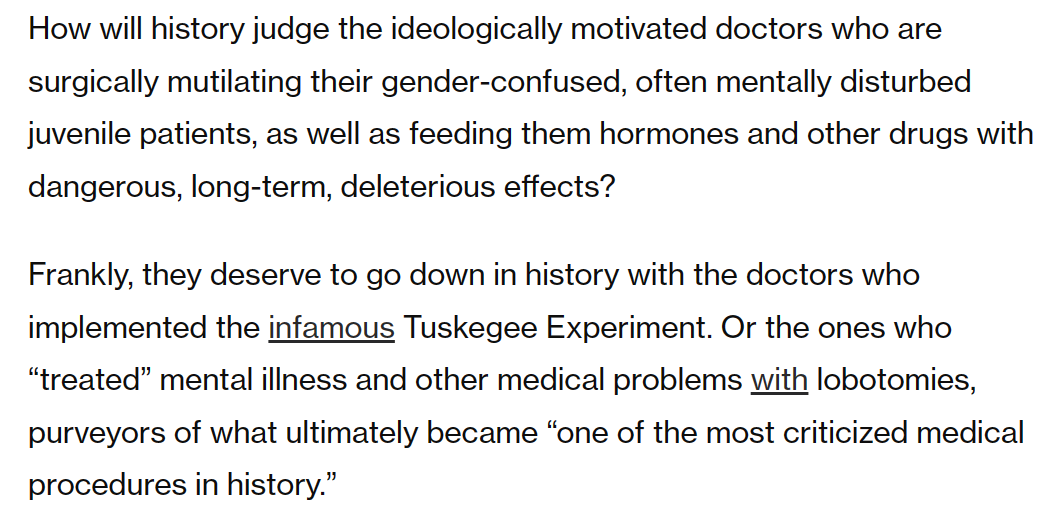Can the History of Lobotomy Tell Us Anything About Transgender Care?
Lobotomy became popular because it made psychiatric patients more pliable and easier to control.
by Evan Urquhart
A story in the Daily Wire today invoked the dark history of lobotomy as a treatment for psychiatric conditions, warning that gender-affirming care is like lobotomy… somehow. The parallels don’t make a lot of sense, but it’s a comparison that’s been bandied about by anti-trans activists online for quite some time, so let’s look at the history of lobotomy and ask if there are any lessons to be learned in the realm of gender medicine today.
Lobotomy was a gruesome surgical procedure, initially developed in the 1930s, that involved severing the connection between a person’s frontal lobe and the rest of their brain. It became widespread during the 1940s in the U. S. and elsewhere after it was championed by a charismatic American doctor, Walter Jackson Freeman II, who believed the procedure represented a revolution in the field of mental health. Freeman developed a quickie version of the surgery that was performed with an icepick driven up through the patient’s eye socket and into their brain. This practice, which seems comically barbaric to a modern audience, didn’t require general anesthesia or the removal of part of the skull. The relative ease of performing this version of a lobotomy greatly helped it spread.
Lobotomies were incredibly risky, with a reported 14 percent mortality rate, and not all patients improved after receiving one. However, what makes them such a dark spot on the history of medicine is what was meant by saying many patients “improved.” Patients became placid and biddable with flat moods and few desires. In a context before psychiatric medications where patients were held indefinitely in hospitals where they were often subject to physical abuse to subdue them, lobotomy was viewed as more humane. Lobotomies swiftly lost favor when psychoactive medications were developed—when doctors had an alternative to spiking a patient’s brain with an icepick, they went with that.
So, how does the Daily Wire connect lobotomies and gender-affirming care? Incredibly superficially, as it turns out. A lobotomy is an outmoded medical intervention the authors know everyone thinks was bad, and they want readers to think gender-affirming care is bad and on the verge of being overthrown. It’s really that superficial: Medical treatment has evolved in the face of new evidence in the past, they want people to remember a particularly gruesome period in medical history, and they’re not worried about making it make sense.
Still, just because the Daily Wire is completely meritless as a publication doesn’t mean we can’t consider the history of lobotomies and ask if there’s anything in that history that might be useful to our thinking about gender-affirming care today. The first parallel that comes to mind is that lobotomies were done to make patients with psychiatric disorders easier for institutions and families to deal with. Instead of thinking purely of what was best for the patient, the needs of those around them came first. This is similar to the demands of parents who want some alternative to gender-affirming care that will make their trans child conform. The best interest of their child is secondary, for this group of parents, to things like religious doctrine, social acceptability, and their ideas about how their child ought to look and act.
Unlike lobotomy, gender-affirming care doesn’t come with a 14 percent risk of death, and it doesn’t turn trans people placid and make them easy to control. This is, in fact, the real source of the objections to transition from many on the right: They want conversion therapy to function like lobotomy, in the sense that they want a treatment that will stop people from wanting things conservatives don’t think they should want and behaving in ways conservatives don’t like. Of course, the harms of conversion therapy are nowhere near as serious and lasting as the harms of lobotomy, and it would be hyperbolic to claims the two things are alike. However, it’s clear there’s one side of the trans debate that has inherited the very attitudes that led lobotomy to become prevalent, and it’s not the gender-affirming side.



